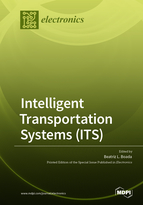Intelligent Transportation Systems (ITS)
A special issue of Electronics (ISSN 2079-9292). This special issue belongs to the section "Electrical and Autonomous Vehicles".
Deadline for manuscript submissions: closed (31 July 2020) | Viewed by 53323
Special Issue Editor
Interests: vehicle control; vehicle safety; Internet of things; sensor fusion; intelligent vehicles
Special Issues, Collections and Topics in MDPI journals
Special Issue Information
Dear Colleagues,
In the last few years, the growth of the number of vehicles in cities has caused problems of mobility, environmental pollution, and road safety. The intelligent transportation system (ITS) concept includes many advanced technologies, such as, communication, sensing, and control, which are used for managing a high amount of information, in order to face these challenges. ITS is a multidisciplinary field that comprises a large number of research areas.
Although tremendous advancements have been made in the last decade in this field, there are still aspects that need to be addressed in order to improve the transportation safety, efficiency, and sustainability.
The topics of interest include, but are not limited to, the following:
- Internet of things/connected vehicles
- Big data
- Electric/autonomous vehicles
- Vehicle control
- Traffic control/traffic management
- Smart sensors
- Smart mobility systems
- Reliability and security in transport
Prof. Dr. Beatriz L. Boada
Guest Editor
Manuscript Submission Information
Manuscripts should be submitted online at www.mdpi.com by registering and logging in to this website. Once you are registered, click here to go to the submission form. Manuscripts can be submitted until the deadline. All submissions that pass pre-check are peer-reviewed. Accepted papers will be published continuously in the journal (as soon as accepted) and will be listed together on the special issue website. Research articles, review articles as well as short communications are invited. For planned papers, a title and short abstract (about 100 words) can be sent to the Editorial Office for announcement on this website.
Submitted manuscripts should not have been published previously, nor be under consideration for publication elsewhere (except conference proceedings papers). All manuscripts are thoroughly refereed through a single-blind peer-review process. A guide for authors and other relevant information for submission of manuscripts is available on the Instructions for Authors page. Electronics is an international peer-reviewed open access semimonthly journal published by MDPI.
Please visit the Instructions for Authors page before submitting a manuscript. The Article Processing Charge (APC) for publication in this open access journal is 2400 CHF (Swiss Francs). Submitted papers should be well formatted and use good English. Authors may use MDPI's English editing service prior to publication or during author revisions.
Keywords
- Internet of things/connected vehicles
- Big data
- Electric/autonomous vehicles
- Vehicle control
- Traffic control/traffic management
- Smart sensors
- Smart mobility systems
- Reliability and security in transport






